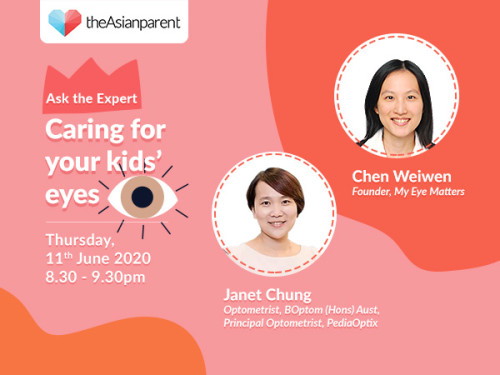Ask the Expert Series: Caring for your kids eyes
According to Singapore National Eye Centre's Myopia Centre (SNEC), by Primary 6 the myopia rate amongst children in Singapore is as high as 65% ? Hence, for this Ask the Expert Session we have TWO experts who will be answering all your questions on myopia and how to care for your kids eyes ?? These two experts are Chen Weiwen: founder of My Eye Matters and Janet Chung: Principal Optometrist, PediaOptix. So start asking your burning questions in the comments section on caring for your kids eyes!


How can we prevent or delay myopia onset in kids?
What is included in an eye exam for my kid?
Dependent on the child’s age, tests relevant to his or her age will be conducted. Most importantly, at an eye exam, the optometrist would be conducting both sight and eye health tests. In a nutshell, tests relating to the child’s sight can include visual acuity (letter reading), refractive error (eye degree), ocular motilities (eye muscles), anterior eye checks and posterior eye checks. Do remember, at different age groups, relevant tests would be conducted with the suitable instruments and methods as the visual system changes.
Is myopia or Astigmatism reverseble?
No, unfortunately. However, the child's refractive power (eye degree) can change as the eye changes, and only stabilizes when they stop growing.
What are the risk factor of myopia?
Myopia is a common refractive error among our school going children in Singapore. Except for congenital myopia which starts at a very young age, school age myopia commonly occurs when the child enters primary school. Risk factors that have been identified with myopia includes: parental myopia, extensive near work (including reading, writing, drawing, usage of handheld devices, etc), lack of outdoor activities etc. Myopia is threatening our child’s vision and we have one of the highest myopic rates among our children and one of the earliest onset (I.e. our kids get it young) in Singapore. The scary thing is, high myopia (defined as -5.00 diopters and more or 500 degrees) is a risk factor of potentially blinding conditions such as retinal detachment, cataracts and glaucoma. Helping a child to manage and to slow down the progression rate is important when myopia sets in.
Can the condition be reversed?
Unfortunately, myopia cannot be reversed. But you can slow down the progression in kids so it does not reach the levels of high myopia (e.g. -5D or 500 degrees or more) which can put them at higher risk of eye illnesses that can cause blindness, such as retinal detachment, cataracts and age-related macular degeneration.
What is strabismus or squints?
This refers to misalignment of eyes, where eyes may appear crossed or drifting away from point of focus. Some parents may first notice as eyes appear not moving together or eyes appear in a daze.
Do blue lens glasses help?
Blue light is everywhere, both indoors and outdoors. The sun emits over 100 times more blue-violet light than digital devices. As we are mostly indoors staring at screens, especially in the last 2 months, blue light can contribute to eye fatigue and make our eyes sensitive to glare. More research needs to be done on the long term exposure of harmful blue light on our eyes. What we know today is that it can age our eyes prematurely and damage the cells in our retina. This can lead to eye diseases such as cataract, floaters, and age-related macular degeneration. Now imagine our young children starting much earlier in their lives on screen time than us! Hence some form of protection such as blue light glasses can help to reduce our risks, especially in young children’s eyes. But this doesn’t mean one can stare at screen long hours non-stop: regular eye breaks are important. Similarly UV protection is equally important, a lot of Asian parents neglect the importance of UV protect
What is lazy eyes?
A lazy eye refers to poor vision in one eye (occasionally both eyes), which is due to imbalance eye degrees between right and left eyes, obstruction in one eye (eg cataracts or tumors) or a squint. So note that a squint can cause lazy eyes, but lazy eyes is NOT a squint.
👍💕
👍






Optometrist @PediaOptix, Mother of 2 teenage kids